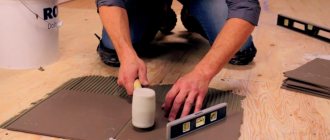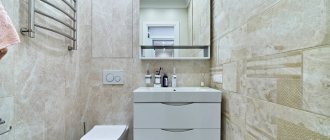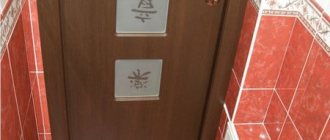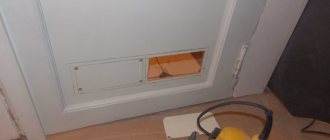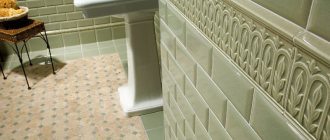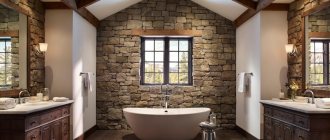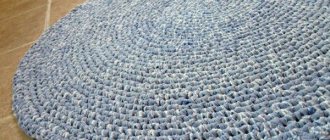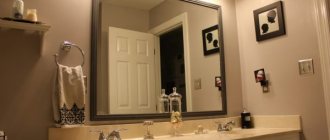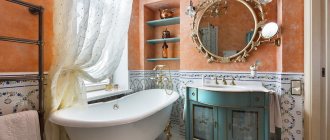Correctly selected linoleum in the bathroom can look no worse than expensive ceramic tiles. Therefore, many builders opt for it when laying flooring in the bathroom. In this case, it is necessary to take into account the features of the future operation of the material, that is, its suitability for use in wet conditions.
Features of using linoleum in the bathroom
It is worth noting that linoleum has never been valued as a floor covering for rooms with constantly high air humidity. None of the existing manufacturers today can boast of a material intended directly for covering floors in plumbing units.
The most problems arise for owners of private houses with wooden floors. Wood is not intended for bathroom conditions, since when exposed to moisture it is irreversibly deformed. Accordingly, the floor covering must be moisture resistant and protect the floors. Based on this, linoleum should be selected solely by characteristics, but not by appearance.
Installation Tips
The most difficult part of the installation process is welding the seams. It is necessary to purchase a cord for termination. They are made in various colors, so choosing the right color is not difficult. Before starting, the joints are cleaned and the seams are soldered. Docked places become one.
Seam welding
Installation of linoleum is carried out in a horizontal position. In places where the material comes into contact with the ceiling or floor, a plinth board is glued on top.
Nuances of purchasing and preparing material
If you have already decided which linoleum is best for your home, then you have already bought it. Before you begin, you should carefully read the instructions that come with the roll materials.
It is important to familiarize yourself with the standard requirements before starting work:
- the material must be adapted to the microclimate of the room, since changes in humidity and temperature changes lead to compression or divergence;
- better coating strength will be achieved if frequent joints between adjacent strips are avoided. The standard roll width is from 2.5 to 4 meters;
- linoleum is not fire-resistant, and therefore it is worth avoiding its fire, since when burning the material emits toxic fumes;
- Before purchasing linoleum, you should carefully measure the room, and also do not be shy and ask for help from managers at a hardware store. Specialists will be able to more accurately think through the amount and type of coating that will be ideal for a room with certain parameters.
Types of coverage
Modern linoleum is made from various materials on natural and synthetic bases.
According to the degree of wear resistance, it is divided into several classes:
• 21-23, or household (for residential premises);
• 31-34, or semi-commercial (for public places);
• 41-43, or commercial (for the industrial sector).
Depending on the structure, linoleum can be homogeneous or heterogeneous:
- Homogeneous. It is a material with a uniform texture, thickness from 1.5 to 3 mm. It has a simple color, often without a pattern. It is resistant to abrasion and retains its appearance for a long time.
- Heterogeneous. Consists of several layers. Its thickness is from 2 to 6 mm. Available in different colors, designs and patterns.
- Baseless is the best option for finishing bathrooms. It has a thickness of 1.2-1.6 mm and is laid on a leveled base.
For bathrooms, PVC coverings with a synthetic base are used. Also on sale are foam-based linoleums, coatings with improved thermal insulation characteristics, etc.
Laying linoleum on a wooden floor
The process of leveling a cement floor has been described many times and will not cause any difficulties for an owner who has the slightest understanding of construction. As for processing floors in a wooden house, it will take more effort and time to create a high-quality base for laying linoleum.
Initially, many wooden buildings are simply not equipped with a bathroom. Owners most often build a kind of plumbing unit in the outbuildings. All they have to do is understand whether it is possible to lay linoleum in the bathroom and how to do it (for more details: “How to lay linoleum on a wooden floor with your own hands”).
In fact, the sequence of actions in this case is very simple:
- the wooden covering must be impregnated with antiseptics, which will preserve the wood in the absence of ventilation due to the tightness of the laid material;
- any unevenness on the surface of the floor beams can lead to deformation of the linoleum, and therefore the floor should be covered with a perfectly flat sheet of chipboard or OSB;
- the linoleum must be allowed to rest for 24 hours, and then it must be glued, not forgetting about the 5-centimeter spacing on the walls (more details: “How long and how long does linoleum rest?”);
- joints between adjacent sheets of material must be hidden. To do this, you can use a hair dryer or Cosmofen glue.
According to residential construction standards, there is a requirement for the floor level in the plumbing unit, and it must be lower than the same surface in other rooms of the house. If such a discrepancy arises, then the risk of accidental spillage of liquid from the bathroom into neighboring rooms can be eliminated by using an inflated threshold that will clamp the linoleum sheet under the door.
If we take into account all the features of wooden floors, we can safely say that linoleum is the cheapest floor covering that resists moisture well and has a long service life. At the same time, such a surface looks aesthetically pleasing, so that it is impossible even to distinguish it from traditional facing materials from a photo or at first glance.
Naturally, for the best design, you need to buy waterproof linoleum with a texture that imitates any of the alternative coatings.
Also, many owners are interested in whether it is possible to lay linoleum in a bathroom that is equipped with its own floor heating system. Naturally, this is permissible, but in this case a special coating should be used, which is appropriately marked, and the documents for this material indicate the maximum temperature level for heating the surface. It is also worth considering that linoleum has poor thermal conductivity and to heat the room you will have to spend a significantly larger amount of energy.
Wall pasting technology
The technique is reminiscent of laying flooring, only the actions must be performed on vertical planes.
The material is allowed to sit for 12 hours until it reaches the temperature of the room in which the work is being done.
You can stick linoleum to the walls yourself by performing the operations in this order:
- Cleaning of the wall is carried out before the concrete slab. Depressions, cracks, and chips are filled with moisture-resistant solutions and putties. The difference is allowed no more than 2 mm per 1 m of surface. Considering the thickness of the material, it is desirable that it be no more than 1 mm. The plane is checked with a construction water level.
- Impregnation with antibacterial primer 2 times (with a drying break of 4 hours). The primer also increases the adhesive properties of the base.
- The adhesive is evenly applied to the wall with a notched trowel in accordance with its manufacturer's recommendations. The thickness of the layer usually coincides with the same size of the sheet (1 - 1.5 mm), the base temperature is not lower than + 10 ° C, but some mixtures, according to the instructions, are preheated and kept for a certain time between stages of preparation. The teeth on the profile are necessary for the release of air and tight contact along the entire plane of the applied material.
- Linoleum, pre-cut to the required size, is applied to the glue and rolled with a roller. If the usual wallpaper is placed vertically, then this material is rolled out horizontally or cut into squares or fragments in accordance with the pattern applied to them. It is advisable to minimize the number of seams, just like with conventional linoleum. The polymer can be cut well with a regular construction knife. If the work is being performed by the contractor for the first time, then you must first practice making joints on scraps of material so that you do not have to move a large sheet over the solution, disrupting the adhesion with the canvas.
- Sealing the seams is designed to seal the hardened adhesive mixture from moisture and changes in air temperature. The best way is to use a special cord (polyurethane) with hot laying. The seam is filled with a polymer rod, which, when melted, fills all the voids and welds the sheets together. Heat the material with a hair dryer, soldering iron or, in extreme cases, an iron. A beautiful and high-quality seam requires certain practical skills. A less reliable method of sealing joints, but one that can be done with your own hands without the involvement of specialists, is cold welding.
- The final step is to decorate the upper and lower edges of the canvas so that the laid linoleum on the wall acquires an aesthetically noble appearance. For this purpose, borders are selected according to colors (matching, transitional to the ceiling and floor, contrasting for differentiation). If necessary, the edges of the sheets are cut in place to a straight line. To learn how to properly glue linoleum, watch this video:
Operation of the premises begins after the glue polymerization process is completely completed. These deadlines are indicated in the instructions attached to it.
Owner reviews
Many owners who have already chosen linoleum as a flooring for plumbing in a wooden house have left reviews on the Internet.
Naturally, there are many opinions and each person has formed his own view on this issue, but most of them agree on a number of points:
- the material is the cheapest among alternative coatings that match the characteristics;
- the installation process is very simple: you just need to stock up on the material itself, a high-quality adhesive mixture and an algorithm of actions, from which you should not deviate, since this is fraught with consequences when using the floors;
- The service life reaches 10 years, and can last longer with careful use. At the same time, the coating retains its tightness and practically does not lose its appearance. Types of coating with texture applied over the entire thickness are very practical. Even with uneven abrasions, in the photo and upon visual inspection they will look like new;
- to avoid injuries, you should purchase a coating that is rough or treated with a special anti-slip compound;
- In the absence of underfloor heating, linoleum can be cold, so you should purchase types that store heat better and can be used without a heating system.
Bottom line
From all of the above, we can conclude that the reliability of the coating cannot be guaranteed if you deviate from a clear algorithm of actions when laying linoleum. This material should be used in cases where it is not possible to lay tiles, porcelain stoneware, parquet and other coverings. If certain difficulties arise with laying linoleum, you should seek help from professionals who will take care of all stages, from purchasing building materials to checking the finished coating.

